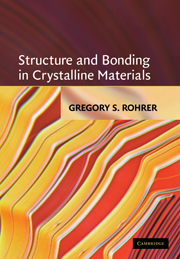Book contents
- Frontmatter
- Contents
- Preface
- 1 Introduction
- 2 Basic Structural Concepts
- 3 Symmetry in Crystal Structures
- 4 Crystal Structures
- 5 Diffraction
- 6 Secondary Bonding
- 7 Ionic Bonding
- 8 Metallic Bonding
- 9 Covalent Bonding
- 10 Models for Predicting Phase Stability and Structure
- Appendix 1A Crystal and univalent radii
- Appendix 2A Computing distances using the metric tensor
- Appendix 2B Computing unit cell volumes
- Appendix 2C Computing interplanar spacings
- Appendix 3A The 230 space groups
- Appendix 3B Selected crystal structure data
- Appendix 5A Introduction to Fourier series
- Appendix 5B Coefficients for atomic scattering factors
- Appendix 7A Evaluation of the Madelung constant
- Appendix 7B Ionic radii for halides and chalcogenides
- Appendix 7C Pauling electronegativities
- Appendix 9A Cohesive energies and band gap data
- Appendix 9B Atomic orbitals and the electronic structure of the atom
- Index
9 - Covalent Bonding
Published online by Cambridge University Press: 23 February 2011
- Frontmatter
- Contents
- Preface
- 1 Introduction
- 2 Basic Structural Concepts
- 3 Symmetry in Crystal Structures
- 4 Crystal Structures
- 5 Diffraction
- 6 Secondary Bonding
- 7 Ionic Bonding
- 8 Metallic Bonding
- 9 Covalent Bonding
- 10 Models for Predicting Phase Stability and Structure
- Appendix 1A Crystal and univalent radii
- Appendix 2A Computing distances using the metric tensor
- Appendix 2B Computing unit cell volumes
- Appendix 2C Computing interplanar spacings
- Appendix 3A The 230 space groups
- Appendix 3B Selected crystal structure data
- Appendix 5A Introduction to Fourier series
- Appendix 5B Coefficients for atomic scattering factors
- Appendix 7A Evaluation of the Madelung constant
- Appendix 7B Ionic radii for halides and chalcogenides
- Appendix 7C Pauling electronegativities
- Appendix 9A Cohesive energies and band gap data
- Appendix 9B Atomic orbitals and the electronic structure of the atom
- Index
Summary
Introduction
The defining characteristic of a covalent bond is the existence of a local maximum in the valence electron density in the regions between the atomic cores. For example, the experimentally measured charge density in Si, illustrated in Fig. 9.1, shows peaks between the atomic positions. From this phenomenon comes the simple idea that two atoms forming a covalent bond share their valence electrons. Concentrating the valence electrons in the spaces between the atomic cores is clearly distinct from the ionic bonding model, where the valence electrons are centered on the anion positions, and the metallic bonding model, where the valence electrons are uniformly distributed in the free electron sea. Therefore, we will have to adopt an alternative model for the description of the valence electrons in a covalently bonded crystal. In the ionic bonding model, it was assumed that valence electrons were transferred from atomic states on the cation to atomic states on the anion. In the metallic bonding model, it was assumed that valence electrons were transferred from atomic energy levels to free electron states. The objective of this chapter is to describe a model for the transfer of valence electrons from atomic energy levels to a new set of crystal energy levels which can be simply thought of as having properties that are intermediate between the atomic energy levels used in the ionic bonding model and the free electron energy levels used in the metallic bonding model.
- Type
- Chapter
- Information
- Structure and Bonding in Crystalline Materials , pp. 363 - 423Publisher: Cambridge University PressPrint publication year: 2001

